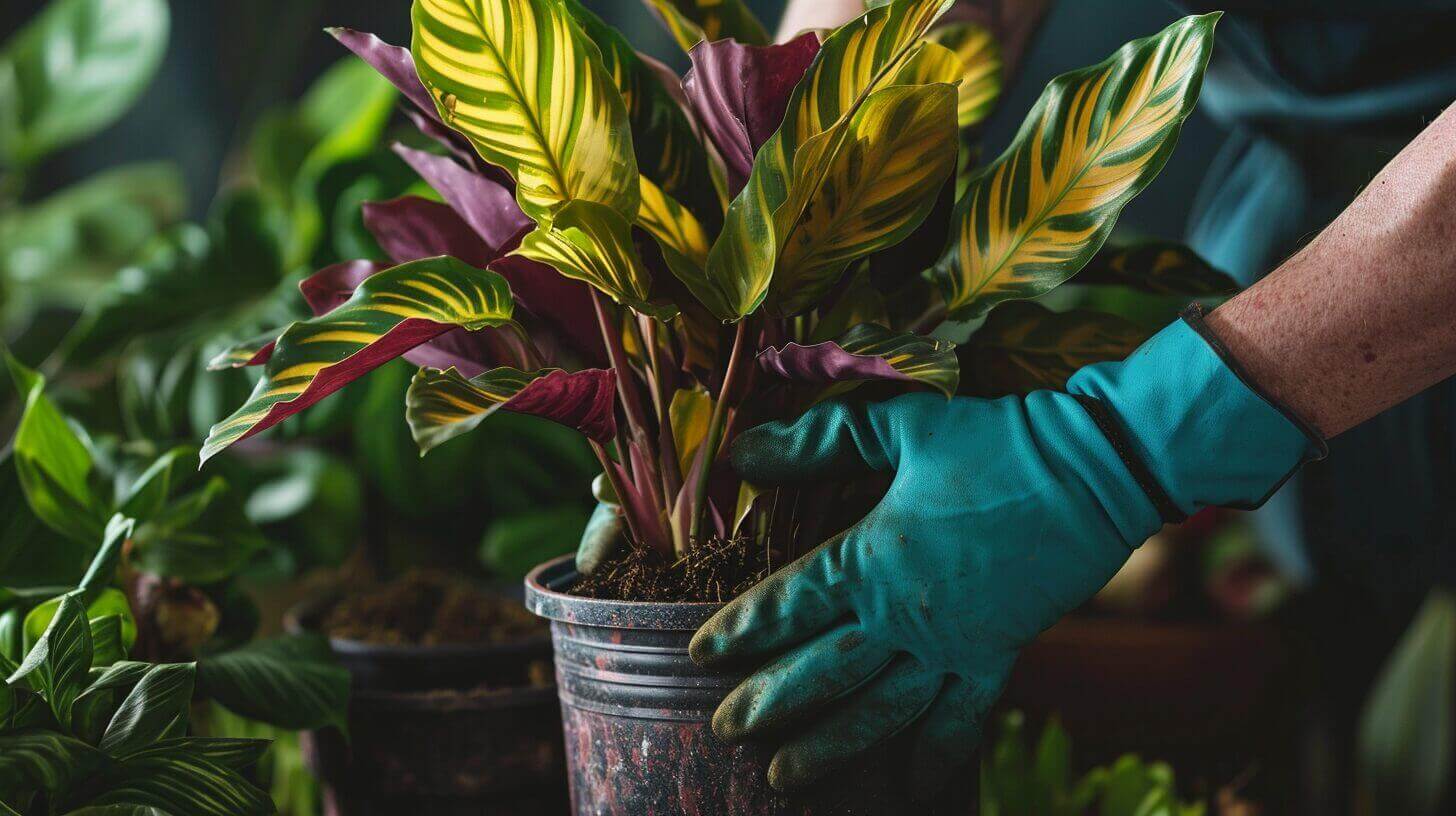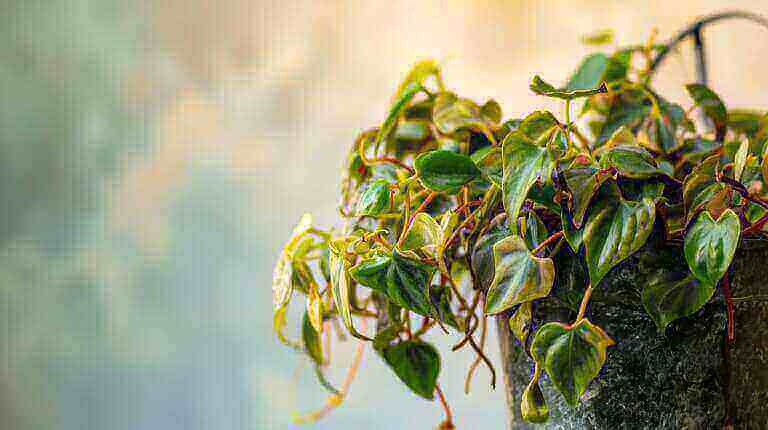Repotting Calathea Houseplants: When to Transplant and How to Do It Right
Calathea houseplants are a beautiful addition to any indoor space, with their vibrant foliage and intricate patterns. However, as these plants grow, they will eventually outgrow their pots and require repotting. Knowing when and how to repot your Calathea can ensure its continued health and vitality. In this article, I will guide you through the process of repotting a Calathea, from identifying the signs that it needs repotting to aftercare to promote new root growth.
Key Takeaways:
- Calathea houseplants should be repotted every one and a half to two years to prevent overcrowding of their root system.
- Signs that your Calathea needs repotting include stunted growth and wilting foliage.
- The best time to repot a Calathea is in early spring when the plant is dormant but about to become active.
- When repotting, use a pot that is 1-2 inches wider than the current one and well-draining potting mix.
- After repotting, avoid fertilizing the plant for the first 4-6 weeks to allow the new roots to establish.
When to Repot a Calathea Houseplant
Repotting a Calathea houseplant is an essential part of its care routine to ensure its continued growth and health. But how do you know when it’s time to repot your Calathea? Here are some signs to look out for:
- Stunted growth: If your Calathea is not growing as vigorously as it used to or has stopped growing altogether, it may be a sign that the roots have outgrown the current pot.
- Wilting foliage: Calatheas are known for their vibrant and lush foliage. If you notice the leaves starting to droop or wilt, it could be an indication that the roots are becoming cramped and the plant is struggling to absorb water and nutrients.
- Roots poking through drainage holes: When you see roots poking out of the drainage holes at the bottom of the pot, it’s a clear sign that the Calathea has become rootbound and needs more space.
Generally, Calatheas should be repotted every one and a half to two years. However, it’s essential to consider the specific needs of your plant, as some varieties may require repotting more frequently than others.
Table: Signs Your Calathea Needs Repotting
| Signs | Description |
|---|---|
| Stunted growth | Slow or no growth compared to the plant’s usual development. |
| Wilting foliage | Drooping or wilting leaves, indicating a lack of water and nutrients. |
| Roots poking through drainage holes | Visible roots protruding from the holes at the bottom of the pot. |
It’s important to note that the best time to repot a Calathea is in early spring when the plant is still dormant but about to enter its growing season. This timing allows the plant to recover from the transplant stress more quickly and promotes new root growth.
How to Repot Your Calathea Houseplant
To repot a Calathea houseplant, you will need a few essential tools and materials. Gather a flat surface, a new pot that is 1-2 inches wider than the current one, a trowel or your hands, well-draining potting mix, and sharp scissors. Before starting, it’s recommended to water your plant the night before repotting to loosen the soil and make it easier to remove from the pot.
Once you have everything ready, follow these simple steps to repot your Calathea:
- Fill the new pot with well-draining potting mix, leaving enough space for the plant to fit comfortably.
- Gently loosen the soil around the edges of the current pot using a trowel or your hands. This will help in easing the plant out of the pot.
- Carefully remove the Calathea plant from its current pot, trying not to damage the roots. You can gently tap the pot on a flat surface or squeeze the sides to loosen the plant.
- Inspect the roots for any signs of damage or pests. Trim any dead or rotten roots with sharp scissors.
- Place the Calathea in the center of the new pot, making sure it sits at the same depth as it was in the previous pot.
- Fill the gaps around the plant with fresh potting mix, ensuring that the roots are covered but not overly compacted.
- Lightly water the plant after repotting, allowing the soil to settle around the roots.
Remember to choose a pot with drainage holes to prevent waterlogging and maintain a well-draining environment for your Calathea houseplant.
Maintaining Healthy Calathea Houseplants
Once you have successfully repotted your Calathea, it’s important to provide proper care to ensure its health and well-being. Here are a few tips to help you maintain a thriving Calathea houseplant:
- Place the plant in a location with bright, indirect light. Avoid direct sunlight as it can scorch the leaves.
- Maintain a consistent temperature between 20 and 24°C during the summer and around 18°C during the winter dormancy period.
- Keep the humidity levels high by placing the plant near a humidifier, misting it regularly, or using a pebble tray filled with water.
- Water the Calathea when the top inch of soil feels dry to the touch. Avoid overwatering, as it can cause root rot and other issues.
- Occasionally wipe the leaves with a damp cloth to remove dust and promote healthy photosynthesis.
- Monitor the plant for any signs of pests or disease, such as yellowing leaves or webbing. Take appropriate measures to address any issues promptly.
By following these care guidelines and repotting your Calathea houseplant when necessary, you can ensure its continued growth and vibrant foliage.
What to Do After Repotting a Calathea Houseplant
After repotting a Calathea, it’s important to provide proper care to ensure its healthy growth and vitality. Here are some essential steps to follow:
1. Avoid Fertilizing
For the first 4-6 weeks after repotting, it’s crucial to avoid fertilizing the Calathea. This gives the plant’s new roots time to establish themselves in the fresh soil. Fertilizing too soon can overwhelm the young roots and impede their growth. Once the 4-6 week period has passed, you can resume your regular fertilizing schedule.
2. Expect Dormancy
After repotting, it’s normal for the Calathea to go through a period of dormancy that can last for at least a month. During this time, the plant will redirect its energy towards root development. Don’t be alarmed if you don’t see any new growth during this period; the plant is focusing on establishing strong roots before it resumes active growth.
3. Provide Ideal Conditions
During the post-repotting period, it’s important to create a conducive environment for the Calathea’s recovery. Place the plant in an area with moderate heat and lighting, ensuring it isn’t exposed to direct sunlight. Calatheas thrive in high humidity, so consider using a humidifier or placing the pot on a tray filled with pebbles and water to increase moisture in the air around the plant. Water the Calathea lightly to avoid overwatering, as the newly repotted plant may be more susceptible to root rot.
By following these care guidelines after repotting a Calathea, you can help promote healthy root development and ensure the plant adjusts well to its new pot and soil. Be patient and allow the Calathea the time it needs to acclimate and resume its growth. With proper care, your repotted Calathea will reward you with lush foliage and vibrant beauty.
The Optimal Location for a Calathea Houseplant
When it comes to finding the ideal location for your Calathea houseplant, there are a few key factors to consider. Calatheas thrive in semi-shady or brightly lit areas, but it’s important to avoid direct sunlight as it can cause leaf burn. These plants also require high humidity, so placing them in a room with adequate moisture is crucial for their well-being.
In terms of temperature, Calatheas prefer a range of 20 to 24°C during the summer months and around 18°C during the winter when they go dormant. It’s important to keep them away from cold drafts and maintain consistent temperatures to avoid any stress or damage to the plant.
Proper care and attention to these light and temperature requirements will ensure that your Calathea thrives in its new home, with lush foliage and vibrant colors to enhance any indoor space.
Key Points:
- Place your Calathea in a semi-shady or brightly lit area, avoiding direct sunlight.
- Ensure high humidity levels by placing the plant in a room with adequate moisture.
- Maintain temperatures between 20 to 24°C during the summer and 18°C during the winter.
- Protect the plant from cold drafts and provide consistent temperatures for optimal growth.
Choosing the Right Soil for a Calathea Houseplant
When it comes to choosing the right soil for your Calathea houseplant, there are a few key factors to consider. Calatheas thrive in well-draining potting mix that retains some moisture. A general all-purpose potting mix is suitable, but you can improve drainage by adding perlite to the mixture. This will prevent waterlogging and ensure that the roots have access to oxygen.
It’s also important to note that Calatheas prefer slightly acidic soil. You can make the soil more acidic by incorporating needle litter, rock meal, or bark mulch into the potting mix. This will create the ideal pH balance for your Calathea and promote healthy growth.
When repotting your Calathea, be sure to choose a pot with drainage holes. This will prevent water from sitting in the bottom of the pot and causing root rot. It’s important to create an environment that allows for proper drainage and aeration, as this will help your Calathea thrive.
Table: Soil Requirements for Calathea
| Soil Type | Characteristics |
|---|---|
| All-purpose potting mix | Suitable for Calatheas |
| Perlite | Improves drainage |
| Needle litter, rock meal, or bark mulch | Makes soil more acidic |
By selecting the right soil and potting mix for your Calathea houseplant, you can create an optimal growing environment that will support its health and well-being. Remember to choose a well-draining potting mix, make the soil slightly acidic, and use a pot with drainage holes. These simple steps will go a long way in ensuring that your Calathea thrives in its new home.
How to Care for a Repotted Calathea Houseplant
After repotting your Calathea, it’s crucial to provide proper care to ensure its health and thriving growth. Here are some essential post-repotting care tips to follow:
1. Watering: Water your repotted Calathea lightly and consistently. Overwatering can lead to root rot, so it’s important to avoid saturating the soil. Instead, let the top inch of the soil dry out before watering again, ensuring that the plant receives adequate moisture without becoming waterlogged.
2. Heat, Light, and Humidity: Place your repotted Calathea in a location with moderate heat and lighting. Avoid exposing it to direct sunlight, as this can cause leaf burn. Calatheas thrive in high humidity, so consider placing the plant in a room with adequate moisture. You can increase humidity by using a humidifier, placing a tray of water near the plant, or misting the leaves regularly.
3. Fertilizing: After repotting, refrain from fertilizing your Calathea for the first 4-6 weeks. This allows the newly established roots to adjust and prevents potential root burn from the fertilizer. Once the plant has settled in its new pot, you can resume regular fertilization with a balanced, water-soluble fertilizer, following the instructions on the packaging.
FAQ
When is the best time to repot a calathea plant?
The best time to repot a calathea plant is in the early spring when the plant is starting its growing season. This gives the plant plenty of time to adjust to its new pot and soil.
How do I know if my calathea needs repotting?
Signs that your calathea may need repotting include root-bound conditions where the roots take up more than half the pot, or if the plant isn’t growing as well as it should. Overwatering and root rot are also common reasons to repot.
What type of pot and soil should I use when repotting my calathea?
When repotting your calathea, use a new pot that’s slightly larger than the current pot. The pot should have a drainage hole to prevent waterlogging. Use a well-draining potting mix, ideally a soil mix designed for houseplants.
How do I repot my calathea plant?
To repot your calathea plant, gently remove the plant from the pot and loosen the soil around the roots. Place the plant in the middle of the new pot and fill with fresh potting soil. Water the plant thoroughly after repotting.
How do I care for my calathea after repotting?
After repotting, place your calathea in indirect light and keep the soil consistently moist. Avoid fertilizing your calathea for a few weeks after repotting to allow the plant to adjust to its new environment.
What are the benefits of repotting my calathea?
Repotting your calathea can promote new root growth, prevent root rot, and give your plant fresh soil filled with nutrients. It can also help if your plant is suffering from root rot due to overwatering.
Can repotting cause transplant shock in calatheas?
Yes, repotting can cause transplant shock in calatheas. To minimize this, try to repot during the plant’s growing season (spring), keep the plant in a stable environment, and avoid drastic changes in light or temperature.
Can I prune my calathea during repotting?
Yes, repotting is a good time to prune your calathea. Remove any yellow or brown leaves to keep the plant healthy. Pruning helps direct more energy to new growth.







